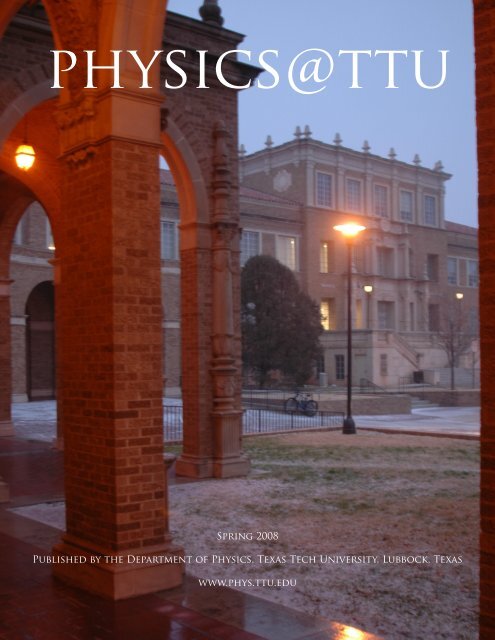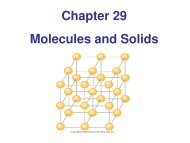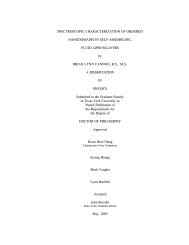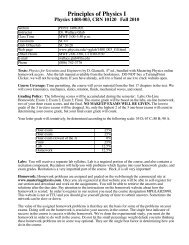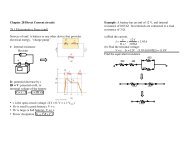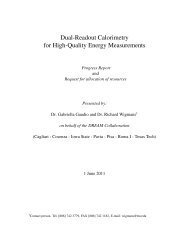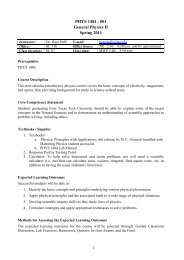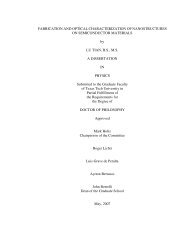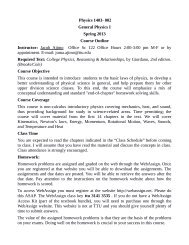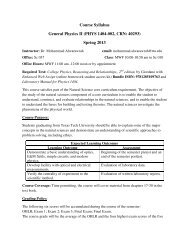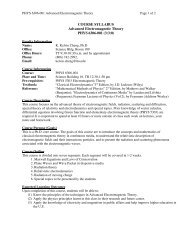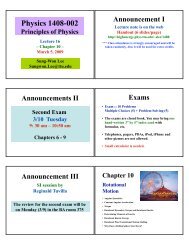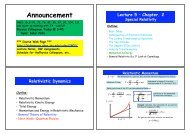Spring 2008 - Department of Physics - Texas Tech University
Spring 2008 - Department of Physics - Texas Tech University
Spring 2008 - Department of Physics - Texas Tech University
You also want an ePaper? Increase the reach of your titles
YUMPU automatically turns print PDFs into web optimized ePapers that Google loves.
physics@ttu<strong>Spring</strong> <strong>2008</strong>Published by the <strong>Department</strong> <strong>of</strong> <strong>Physics</strong>, <strong>Texas</strong> <strong>Tech</strong> <strong>University</strong>, Lubbock, <strong>Texas</strong>www.phys.ttu.edu
The View from the ChairSince August 1, 2007, I have had the privilege and pleasure<strong>of</strong> serving as the department chair <strong>of</strong> physics atTTU. I am excited about the great potential evidentall around me, and I would like to share a few thoughtsabout where we are as a department and the direction Iwould like us to take in the future.This semester, <strong>Spring</strong> <strong>2008</strong>, we have introduced two specialsections <strong>of</strong> introductory physics for our majors, <strong>Physics</strong> Iand II. We have also instituted a fresh approach to teachingintroductory labs, with the focus more on inquiry thanon following a predetermined recipe. Teaching assistantswho are responsible for these labs are also required to take agraduate course in which these modern pedagogical methodsare covered. We are currently searching for a Director<strong>of</strong> Instructional Laboratories, a newly generated staff positionthat requires an advanced degree. There are severalother changes ahead <strong>of</strong> us in the undergraduate program,including the upgrading <strong>of</strong> all levels <strong>of</strong> undergraduate labs(<strong>Physics</strong> III, sound/music, optics, and advanced), better sequencing<strong>of</strong> courses for majors, the introduction <strong>of</strong> a capstoneproject, and so on. As we introduce changes to ourcurricula, we will evaluate the student learning outcomes,and I should be able to report on these in the next issue <strong>of</strong>physics@ttu.Our Engineering <strong>Physics</strong> undergraduate program was revisitedin October 2007 by the accreditation agency (ABET),which followed up on the previous review that took placein 2005. With the agreement and the support <strong>of</strong> the College<strong>of</strong> Engineering and the College <strong>of</strong> Arts and Sciences, Ihave undertaken the mission to not only “fix” this programbut to build a modern and competitive curriculum thatwill be at the leading edge <strong>of</strong> critical issues in science andengineering. This program will address the most relevantproblems <strong>of</strong> our time, for instance, energy, materials, environment,and communication. We now have a task forcedesigning this unique major, about which they will make acomplete proposal in May <strong>2008</strong>. I welcome participationand input from our alumni concerning this critical and ambitiousproject.Our astronomy courses have been attracting increased enrollment.Both the solar and stellar astronomy classes arefilled to the brim this semester, and the Gott Skyview Observatorynear Shallowater is increasingly utilized by thesestudents to observe the night skies. We are renovating thisfacility to provide a larger telescope, an enlarged structurearound the dome, ADA-compliant access to the main telescope,a classroom, and the observatory’s first bathroom. Iwelcome support from our alumni for these significant improvements.The research productivity in our department is on the rise.The number <strong>of</strong> faculty with publications shows an increasingtrend: 10 in 2001, 12 in 2002, 11 in 2003, 12 in 2004,15 in 2005, and 17 in 2006. And the number <strong>of</strong> refereedpublications by our faculty went up to more than 60 in2006 from 36 in 2001. The annual external funding levelshave hovered around $2M for the last six years, fluctuatingsomewhat in response to faculty departures and additions.Our faculty is striving hard to garner new researchdollars, and we are committed to exploring all possibilitiesto increase the kind <strong>of</strong> externally funded research that willpromote intellectual depth in both our undergraduate andgraduate programs.Last semester, I streamlined the way faculty memberscontribute to the running <strong>of</strong> the department. Now, fourgroups carry the main load: Undergraduate Affairs, GraduateAffairs, Faculty Affairs, and Infrastructure/Facilities.These working groups are convened by Pr<strong>of</strong>essors Thacker,Lichti, Estreicher, and Huang, respectively, and each groupcomprises approximately five faculty members. Pr<strong>of</strong>essorThacker is also Associate Chair. We are very fortunate inour committed, hard-working, and creative faculty.We have been additionally blessed with generous scholarshipendowments from our <strong>Tech</strong> family. These scholarshipsenable many students to fulfill their dreams towards a pr<strong>of</strong>essionalcareer in science and technology. We rely heavilyon our alumni and friends for their continued support.| physics@ttu | spring <strong>2008</strong> | page 3 |
Figure 2: Time-evolution <strong>of</strong> the secondary structures <strong>of</strong> beta-amyloid in three molecular environments: solution (T = 300 K), solution (T=400 K) and the surface <strong>of</strong> lipid membrane containing cholesterol nano-domains (T = 300 K).| physics@ttu | spring <strong>2008</strong> | page 6 |an essential contribution to normal physiological pathwaysand defense mechanisms inside our bodies. However, someprotein cleavage products may misfold and self-aggregateupon their release. Failure to get rid <strong>of</strong> these aggregatedproducts has been known to be the leading cause <strong>of</strong> the“protein-aggregation” diseases, e.g., Bovine spongiform encephalopathy(mad-cow disease), Huntington’s, Parkinson’s,and Alzheimer’s. The detailed mechanisms <strong>of</strong> how and whycertain proteins undergo misfolding and aggregation arestill unknown.Among various “protein-aggregation” diseases, Alzheimer’sdisease has been <strong>of</strong> particular scientific interest for decades.It is estimated that one in ten persons over age 65 and abouthalf <strong>of</strong> those 85 or older have this progressive and incurabledisease. Currently, it has affected more than five millionAmericans, and that number could more than triple bymid-century as our population ages. Most scientists believethat the misfolding and self-aggregation in the brain <strong>of</strong> aparticular protein, beta-amyloid, are the major molecularevents that trigger the early onset <strong>of</strong> Alzheimer’s disease.Beta-amyloid is a short protein that consists <strong>of</strong> only 39 to43 amino acid residues. According to the current AmyloidCascade hypothesis, beta-amyloid is released from the controlledcleavages <strong>of</strong> a large beta-amyloid precursor proteinin the neurons <strong>of</strong> the brain by two proteases, beta and gammasecretases. It is believed that beta-amyloid is a normalmetabolic product in the neurons. However, some freelyreleased beta-amyloid chains may misfold and aggregateto form highly toxic oligomers, which attack the surface <strong>of</strong>neurons in the brain. Subsequent self-assembly <strong>of</strong> the toxicoligomers, or pre-fibrils, results in an irreversible accumulation<strong>of</strong> amyloid fibrils on neurons, the hallmark <strong>of</strong> endstageAlzheimer’s disease found in the brains <strong>of</strong> patients.To design effective therapy for this disease, an understandingat the atomistic level <strong>of</strong> the misfolding and aggregationevents <strong>of</strong> beta-amyloid is urgently needed. At present, thedetailed structures <strong>of</strong> the misfolded monomer and oligomers<strong>of</strong> beta-amyloid are still not clear. Knowledge <strong>of</strong> thesestructures will provide important clues for developing newtherapeutic intervention, known as anti-aggregation therapy,that will target beta-amyloid early aggregation for thetreatment <strong>of</strong> Alzheimer’s disease. At present, most researchefforts are focused on the misfolding and aggregation events<strong>of</strong> beta-amyloid in the solution phase. Very little, if any, isknown about similar events on the surface <strong>of</strong> neurons, theprimary target <strong>of</strong> beta-amyloid in the disease progression <strong>of</strong>Alzheimer’s disease.
From a computational standpoint, thereason for this lack <strong>of</strong> detailed informationabout the misfolding and aggregationevents <strong>of</strong> beta-amyloid and theirstructures on the neuronal membranesurface is the difficulty <strong>of</strong> creating a realisticneuronal membrane surface mimic.Previous computational studies onbeta-amyloid/membrane interactionsfocused on simple one-component andcontinuum lipid membrane systems thatfailed to capture the molecular organizations<strong>of</strong> certain key membrane components(lipids) and atomistic interactionsbetween the lipids and beta-amyloidmolecules.Recently, we have successfully designedand constructed a multi-componentneuronal membrane mimic with nanoscalearchitecture. This model membraneconsists <strong>of</strong> a bilayer made <strong>of</strong> cholesteroland phosphatidylcholine, the major lipidsfound in neurons. In addition, cholesterolnano-domains <strong>of</strong> defined lateralorganization have also been simulated.Recent studies have indicated that thesenano-domains are dynamically stablestructures in lipid membranes. Also,they can regulate the activities <strong>of</strong> certainmembrane surface acting proteins and the amyloid cascadeprocess leading to Alzheimer’s disease. However, the mechanismby which these nano-domains affect the misfoldingand aggregation <strong>of</strong> beta-amyloid on the lipid membranesurface remains unknown and constitutes the major focus<strong>of</strong> our work.To explore the folding and aggregation events <strong>of</strong> beta-amyloidon the neuronal membrane mimic with nano-domains,we plan to utilize a computational approach involving bothcoarse-grained and all-atom molecular dynamics (MD)simulations. This new hybrid MD method will allow usto sample a large configuration space, achieve simulationtimes in milliseconds, and reveal atomistic details <strong>of</strong> conformations-- all necessary to unraveling the complexities<strong>of</strong> protein folding and aggregation events on membranesurfaces.Pr<strong>of</strong>essor Kelvin Cheng (kelvin.cheng@ttu.edu), a biophysicist, hasbeen with our department since1989. One <strong>of</strong> his recent interestsis protein folding and its ramificationsfor our health. He explains hiswork on a computational approachto explore the early misfolding andaggregation events <strong>of</strong> Alzheimer’sbeta-amyloid proteins on the neuronsurface. Pr<strong>of</strong>essor Cheng is teachinggraduate-level Molecular Biophysicsthis spring.Figure 1 summarizes the design framework <strong>of</strong> our computationalstudy. Here, we first constructed the monomeric beta-amyloidin the α-state. We then constructedtwo water/protein/membranemolecular clusters, one with the proteinpartially inserted in the lipid membraneand the other with the protein lying onthe lipid membrane surface (Figure 1B).The lipid membrane surface shown hereconsists <strong>of</strong> 40% cholesterol, a biologicallyrelevant lipid composition found inthe neurons, with stable highly orderedcholesterol nano-domains. Finally, weconstructed a third cluster consisting <strong>of</strong>water/protein only and in the absence <strong>of</strong>the lipid membrane that serves as a control.Some initial results <strong>of</strong> the intermediatestate, or partially folded beta-amyloid(I-state) and completely unfoldedprotein (γ-state) in solution, are shownin Figure 1A. The aggregated beta-sheetstack structure (β-state) <strong>of</strong> beta-amyloidin solution published by another researchgroup is also shown for comparison.Figure 2 shows our 5-ns simulation data<strong>of</strong> beta-amyloid in three different environments:with the solution at T = 300K and 400 K, and on the membrane surfacewith cholesterol nano-domains atT = 300 K. It is clear that the misfoldingpathway <strong>of</strong> the protein in the 3D isotropicsolution phase is distinctly different from that on the2D membrane surface with cholesterol nano-domain structures.The appearance <strong>of</strong> beta sheet (red) and turn (yellow)structures is a signature <strong>of</strong> the misfolding regions <strong>of</strong> theprotein that may lead to the development <strong>of</strong> a beta-sheetstack, the currently hypothesized structure <strong>of</strong> the toxic oligomer<strong>of</strong> beta-amyloid (Figure 1A).Our plan is to compare the structures <strong>of</strong> our aggregated state<strong>of</strong> beta-amyloid on the membrane surface and in solutionwith the published toxic oligomer structures in solution,and to examine the stability <strong>of</strong> the protein that is partiallyinserted in membrane. The latter mimics the structure <strong>of</strong>the protein immediately after its release from the cleavages<strong>of</strong> the large beta-amyloid precursor protein. We anticipatethat our information-rich MD simulation data will provideunique opportunities for data mining, i.e., the search forthe unique conformations <strong>of</strong> the protein that will help usto design drugs that target the misfolding and self-aggregationstructures <strong>of</strong> beta-amyloid. Two Ph.D. students and| physics@ttu | spring <strong>2008</strong> | page 7 |
Dr. Mark Vaughn from the TTU Chemical Engineering<strong>Department</strong> are also involved in this project. The WelchResearch Foundation, NSF, and HPCC <strong>of</strong> TTU providesupport.ON THE WEBFor a 200-ns simulation <strong>of</strong> all-atom simulations <strong>of</strong> PC/cholesterolnano-domains:www.phys.ttu.edu/~kcheng/hpcc/CR_Z1.mpgThe polar atoms <strong>of</strong> PC are in blue, the cholesterol polarhead group is in yellow, the hydrophobic chains are in lightblue, and water molecules are in red/white dots.For a 5-ns all-atom simulation <strong>of</strong> the unfolding <strong>of</strong> Alzheimer’sbeta amyloid protein on lipid nano-domains:www.phys.ttu.edu/~kcheng/hpcc/alphaSL_SU.mpgThe protein is in white. The lipid polar atoms (cholesterolin pink and PC in blue) are also shown.Society <strong>of</strong> <strong>Physics</strong> StudentsStephen Torrence, the president <strong>of</strong> SPS, says the societyprovides an opportunity for physics and engineeringphysics students to meet, collaborate, and generallyshare their passion for the field. He invites all interestedstudents to participate in the society’s activities. He can becontacted at stephen.torrence@ttu.edu.SPS organized two activities in 2007: Ballistics Day, hostedby Pr<strong>of</strong>essor Glab, and the Star Party Picnic at the GottSkyview Observatory, which was co-hosted by the SouthPlains Astronomy Club. Both were well attended.Planned future activities include a lecture on medical physicsby Dr. Murali Nair from the Joe Arrington Cancer Centerand a visit to his facilities at Covenant Hospital. Additionally,a visit is planned to the Nano <strong>Tech</strong> Center thisspring.SPS <strong>of</strong>ficers Eric Andersen (left), Anthony Chappa, Stephen Torrenceand George Laity (front) are seen at the 2007 banquet.| physics@ttu | spring <strong>2008</strong> | page 8 |SPS traditionally organizes the annual <strong>Spring</strong> ScholarshipBanquet. This year’s award ceremony is scheduled forThursday April 10th at 3:30 PM in the Science Buildingand will be followed by a banquet at the Merket AlumniCenter. We would love alumni to attend this event. Thoseinterested should contact the department <strong>of</strong>fice. Each banquetfeatures invigorating disquisitions. For instance, Pr<strong>of</strong>essorBorst shared his critical analyses <strong>of</strong> student learningdata at the 2007 <strong>Spring</strong> Scholarship Banquet (right).
Magnetic PolaronsRoger LichtiAs my primary research over the past fifteen yearsor so, I have investigated the physical and chemicalbehavior <strong>of</strong> the hydrogen atom as an interstitialimpurity in semiconductor materials by using implantedpositive muons to form a very light, short-lived ‘isotope’ <strong>of</strong>hydrogen known as muonium. This work has been verysuccessful and has provided much <strong>of</strong> the experimental basisfor our current understanding <strong>of</strong> isolated hydrogen impuritiesin these materials as the precursor to technologicallyimportant defect chemistry in which hydrogen reacts withother defects to help stabilize electrical and optical propertiescritical to devices like semiconductor lasers.Very recently, I have joined with colleagues from theKuchatov Institute in Moscow and the <strong>University</strong> <strong>of</strong> BritishColumbia in Vancouver to use muons to study the details<strong>of</strong> magnetism on the microscopic scale in ferromagnetic(FM) semiconductors, which are candidate materials for‘spintronics’ devices. Here the muon serves as a sensitiveprobe <strong>of</strong> local magnetic fields and their fluctuations. Thedata we obtain on the atomic scale distribution <strong>of</strong> internalmagnetic fields will help decide between competing theories<strong>of</strong> FM interactions in diluted magnetic semiconductors(DMS), such as GaAs doped with Mn, which showsa maximum T c<strong>of</strong> about 160 K. Mn-doped GaAs is p-typeand the holes mediate the FM coupling between Mn 2+ ions,but details are not yet understood. Other materials, such asthe II-IV-V 2chalcopyrites, are being developed in an effortto reach room temperature ferromagnetism in a functionalsemiconductor so as to make spin-based devices commerciallyviable. We observe ordered magnetism up to 350K inMn-doped CdGeAs 2.A second method <strong>of</strong> introducing spin into a functional deviceis to inject spin-polarized electrons into the active region<strong>of</strong> a transistor, using magnetic layers in traditional siliconbased ICs, for example. Interface barriers make magneticmetals very poor injectors, but concentrated ferromagneticsemiconductors such as EuS can work, although its T c=16.5 K. However, the concentrated FM semiconductorsshow a number <strong>of</strong> precursor effects well above T cthat canbe explained by development <strong>of</strong> magnetic polarons. Theseare small regions <strong>of</strong> FM order in which a quasi-localizedelectron couples with the magnetic ions inside its somewhatextended wave function. Free magnetic polarons only existjust above T c, but an electron weakly bound to a positivelycharged impurity can form a bound magnetic polaron atmuch higher temperatures. Destruction <strong>of</strong> these polaronsby an electric field should release spin-polarized electronsand may bypass the requirement <strong>of</strong> long-range FM orderfor a useful spintonics device.We recently discovered a muon spin precession spectrumin EuS that has many <strong>of</strong> the features anticipated for a magneticpolaron. The implanted muon serves both as the impuritywhich captures an electron to initiate formation <strong>of</strong>this bound magnetic polaron and as a probe <strong>of</strong> its characteristics.We have obtained dependences on both temperatureand applied magnetic field that allow us to determineboth the size and magnetic moment <strong>of</strong> the muon-inducedmagnetic polaron in EuS. We have found similar spectra infive other semiconductors with an FM ground state: EuO,EuSe, and three members <strong>of</strong> a second class <strong>of</strong> FM semiconductors.The experimental methods we use are known as MuSR,which stands for muon spin rotation, relaxation, or resonance,depending on the exact technique. These are variants<strong>of</strong> magnetic resonance that make use <strong>of</strong> the effects <strong>of</strong>parity violation in both the production <strong>of</strong> muons frompion decay and in the decay <strong>of</strong> muons themselves. Ourexperiments use three international MuSR User Facilities:TRIUMF in Vancouver, the ISIS Facility <strong>of</strong> the RutherfordAppleton Laboratory near Oxford in the UK, and the PaulScherrer Institute (PSI) in Switzerland. These labs producebeams <strong>of</strong> 100% spin polarized 4.1 MeV muons, whichare implanted into our samples. When a muon decays, apositron is emitted preferentially along the instantaneousdirection <strong>of</strong> the muon’s spin, allowing us to determine thetime evolution <strong>of</strong> muon spin on average from histogramscomposed <strong>of</strong> roughly 10 million muon decay events perdata point. The muon lifetime <strong>of</strong> 2.2 μs and its Larmor pre-| physics@ttu | spring <strong>2008</strong> | page 9 |
cession frequency <strong>of</strong> 135.5 MHz/Tesla determine the basictime scale for the sensitivity <strong>of</strong> MuSR techniques.The insert in the accompanying figure shows the spectrumthat is assigned to a magnetic polaron in EuS. Data wereobtained at TRIUMF using a MuSR spectrometer withhigh frequency resolution in fields up to 7.0 Tesla. The centralline is from muons that have not captured an electron,while the two outer lines are from the magnetic polaron,specifically from muon spin-flip transitions with the electronspin either “up” or “down.” As the temperature is lowered,the splitting increases and its field dependence eventuallysaturates, as shown at 90 K. These dependences andother features easily distinguish this spectrum from that <strong>of</strong>any standard neutral muonium species.| physics@ttu | spring <strong>2008</strong> | page 10 |Our model for this spectrum is currently rather simplified,assuming a spherical s-state electronic wave functionthat extends over a region containing N magnetic Eu 2+ions. Without the magnetic ions, one would see a splittingequal to the electron-muon hyperfine constant, whichin the simplest model <strong>of</strong> a donor impurityyields both the binding energy andradius <strong>of</strong> the electron’s wave function.We modified this picture to replace theelectron magnetic moment with the totalpolaron magnetic moment, creatingthe hyperfine field sensed by the muon.The observed saturation at 90 K yields asaturated hyperfine constant <strong>of</strong> roughly37 MHz. Combined with the low-fieldslope, we get a net polaron moment <strong>of</strong>between 35 and 40 μ Band a net polaronspin <strong>of</strong> 18 - 20. These values yield a polaronradius <strong>of</strong> nearly 0.7 nm, which inturn should enclose roughly 15 magneticions. More detailed fits that includeamplitudes <strong>of</strong> the spectral lines and theinferred electron spin polarization willrefine these numbers, and a more realisticmodel <strong>of</strong> the couplings between anelectron and the magnetic ions will be requiredto complete our characterization<strong>of</strong> the magnetic polaron in EuS. Thesedata constitute the first spectroscopicevidence and direct characterization <strong>of</strong>a magnetic polaron. A publication announcingthese results is currently in thefinal stages <strong>of</strong> preparation.Pr<strong>of</strong>essor Roger Lichti (roger.lichti@ttu.edu)specializes in condensedmatter physics. He has been on theTTU faculty since his arrival in1979 as an assistant pr<strong>of</strong>essor. Inthis article, he shares with us his recentdiscovery <strong>of</strong> magnetic polarons.Pr<strong>of</strong>essor Lichti is the convener <strong>of</strong>the Graduate Affairs Group andwill also serve as the graduate advisorbeginning June 1, <strong>2008</strong>.The initial MuSR spectroscopy <strong>of</strong> a magnetic polaron --along with a number <strong>of</strong> other early results demonstratingwell ordered internal magnetic fields below the orderingtemperature and development <strong>of</strong> magnetic features aboveT cfor both the concentrated and diluted ferromagneticsemiconductors -- shows great promisefor MuSR techniques to yield uniquenew information on the materials beingdeveloped for possible spintronics applications.This growing collaborationwill soon begin using a very unique lowenergymuon spectrometer at PSI to investigateinternal magnetic fields in thinlayers <strong>of</strong> magnetic semiconductors as afunction <strong>of</strong> depth in geometries muchmore relevant to potential devices. Wehave obtained well characterized samplesfrom some <strong>of</strong> the world’s leading materialsdevelopment groups working in thisfield and expect eight to ten weeks <strong>of</strong>MuSR Facility time to be allocated tothis overall project during <strong>2008</strong>.ON THE WEBwww.isis.rl.ac.uk/muonsmusr.orglmu.web.psi.chwww.phys.ttu.edu
A Tale <strong>of</strong> Two HalosRon WilhelmAstronomical research in the <strong>Department</strong> <strong>of</strong> <strong>Physics</strong>at <strong>Texas</strong> <strong>Tech</strong> has been experiencing a renaissancefor the past six years. This past year, we marked theculmination <strong>of</strong> several years <strong>of</strong> intense stellar research witha discovery publication in Nature (Carollo et al, Volume450, 13 December 2007), entitled Two Stellar Componentsin the Halo <strong>of</strong> the Milky Way. This paper shows for the firsttime that the halo <strong>of</strong> our Milky Way galaxy is composed <strong>of</strong>two distinct populations <strong>of</strong> stars.The Milky Way galaxy, like most other spiral galaxies, hasthree main components <strong>of</strong> stars: a central bulge, a disk withspiral arms, and an outer halo <strong>of</strong> very ancient stars. The insertbelow shows an image <strong>of</strong> the Sombrero Galaxy, whichis seen nearly edge-on to the disk.The halo <strong>of</strong> the Milky Way is <strong>of</strong> great interest to astronomersbecause it contains the first population <strong>of</strong> stars that formedin the Galaxy. Most have ages <strong>of</strong> nearly 13 billion years.Because these were the first stars to form in the Galaxy, theyare exceptionally good stars for probing the mechanisms atwork during the formation and early evolution <strong>of</strong> the MilkyWay. For decades, astronomers have studied small samples<strong>of</strong> halo stars, and the data from these studies suggested thatour Galaxy may have formed as a single giant gas cloud thatcollapsed under gravity to form the bulge and disk that wesee today. In this scenario, the halo stars were thought t<strong>of</strong>orm as the gas fell inward, toward the center <strong>of</strong> the Galaxy.As the gas fell in, the slight amount <strong>of</strong> rotation in the gas increasedand caused the gas to flatten into a disk, just as pizzadough being tossed and spun in the air can be flattened intoa thin crust. Unlike the gas (which can suffer collisions),the halo stars that formed could not fall into the disk <strong>of</strong>the Galaxy because they had no way to change their orbits(they are collision-less) and therefore remained distributedthroughout the halo.With large telescopes to capture spectra <strong>of</strong> stars, it is possi-| physics@ttu | spring <strong>2008</strong> | page 11 |
le to directly examine the atomic elements that make up agiven star. The first stars to form in the universe were composed<strong>of</strong> only hydrogen and helium. All the other elementswere forged in the nuclear furnaces <strong>of</strong> stars and spread backout into the universe when the stars exploded at the end <strong>of</strong>their lifetimes. New stars that form from a mixture <strong>of</strong> thisprocessed gas have a greater abundance <strong>of</strong> these newer elements.When astronomers examined the stars in the halo<strong>of</strong> the Galaxy, they discovered that these stars have veryHowever, for the past 20 years this model <strong>of</strong> a single, monolithiccollapse for the Galaxy has been brought into seriousquestion. In this model, it is expected that an intermediatepopulation <strong>of</strong> stars should be found in the halo thatcontain more processed elements and that orbit at speedsbetween that <strong>of</strong> the halo and the disk <strong>of</strong> the Galaxy. Thisintermediate population has never been found, suggestingthat the Galaxy may have been built up over time from thein-fall and disruption <strong>of</strong> smaller satellite galaxies that orbitFigure 2: The distance above the disk <strong>of</strong> the Galaxy (Z) versus the distance from the center <strong>of</strong> the Galaxy. The contours are color coded to showthe density <strong>of</strong> stars --red represents the highest density. The top row plots are for processed elemental abundances that were previously consideredtypical for the halo. The bottom plots represent stars that are very deficient in processed materials, with the bottom right plot showing the mostdeficient stars. Notice the halo shape changes from a flattened distribution to more spherical in the final plot.| physics@ttu | spring <strong>2008</strong> | page 12 |few processed elements, with some having fewer than onethousandththe abundance <strong>of</strong> that <strong>of</strong> our own Sun. Furthermore,data on the motion <strong>of</strong> these stars showed that thehalo barely rotated around the Galactic center, unlike thedisk that rotates at several hundred kilometers per second.These two factors suggested that when the gas in the halowas beginning to collapse to form the Milky Way, the firststars formed from nearly pristine hydrogen and helium gas,and that this gas had not yet begun to spin rapidly aroundthe Galaxy.around the Galaxy. This model is known as a “bottom-up”model which posits large galaxies forming from the merger<strong>of</strong> many smaller galaxies. This model is also consistent withexpectations from theoretical models that predict how galaxiesformed in the early universe.The discovery <strong>of</strong> the two halos around the Milky Way isvery important new evidence about how the Galaxy formed.This discovery was made through the analysis <strong>of</strong> over 20,000stars from the Sloan Digital Sky Survey (SDSS). In thepast eight years, the SDSS has accumulated spectra <strong>of</strong> over
one million external galaxies and nearly250,000 stars in our Galaxy. I haveworked for the past four years in collaborationwith astronomers from SDSSinstitutes to develop reliable s<strong>of</strong>twareto analyze the enormous spectroscopicdatabase at the SDSS. The fruits <strong>of</strong> thislabor are now being realized in that wehave determined velocity and processedelemental abundances and distances totens <strong>of</strong> thousands <strong>of</strong> stars in the Galactichalo. Analyzing this enormous sampleallowed us to determine for the firsttime that two distinct stellar populationsexist in the halo, one dominatingat nearer distances (the inner halo) andone dominating at greater distances (theouter halo).astronomer.The inner halo is slightly flattened, likea football and outlines the much flatterdisk <strong>of</strong> the Galaxy. The amount <strong>of</strong>processed elements is greater than in theouter halo, and the inner halo rotatesslightly in the same direction as the disk.The outer halo is more spherically distributedaround the Galaxy, like a basketball,and extends to greater distances than theinner halo. It has significantly fewer processedmaterials than the inner halo and, surprisingly, has asignificant rotation that is in the opposite direction <strong>of</strong> thedisk. In the past, this outer halo has been difficult to detectbecause the orbits <strong>of</strong> the stars in the outer halo carry theminto the inner halo, where they spend a large percentage<strong>of</strong> their time. Since most surveys <strong>of</strong> stars, including SDSS,probe the inner halo region, results are confounded by themixture <strong>of</strong> inner and outer halo components. Only with thePr<strong>of</strong>essor Ron Wilhelm (ron.wilhelm@ttu.edu)is an observationalHe came to TTU in2001 as an assistant pr<strong>of</strong>essor andhas recently been promoted to the associatepr<strong>of</strong>essor rank. Pr<strong>of</strong>essor Wilhelmis teaching Principles <strong>of</strong> <strong>Physics</strong>I for our majors’ section this semester.His recent research was featured inthe prestigious Nature magazine’sDecember 13, 2007 issue.high precision analysis <strong>of</strong> this enormousnumber <strong>of</strong> SDSS stars and the inclusion<strong>of</strong> the velocity, abundance, and distancedata is it possible to separate these twopopulations. The contour plot from theNature article shows the change from aflattened halo to a more spherical halowhen the SDSS data is binned in orbitalvelocity, abundance, and distance.The outer halo is expected to have arisenfrom the disruption <strong>of</strong> the one or moresatellite galaxies that were orbiting theMilky Way counter to the rotation <strong>of</strong>the Milky Way disk. It would not bepossible for a population to orbit counterto disk rotation if the Galaxy wereformed as part <strong>of</strong> a monolithic collapse.This outer halo confirms that the MilkyWay has been built up, in part, fromsmall galactic systems. The origin <strong>of</strong> theinner halo still remains uncertain andcould either be part <strong>of</strong> the collapse <strong>of</strong> alarge gas cloud or the remnants <strong>of</strong> manyearly mergers. In any case, this currentresult is a crucial piece <strong>of</strong> evidence thatwill help to solidify our understanding<strong>of</strong> the origin <strong>of</strong> the Milky Way and othergalactic systems.Astronomy research in the <strong>Department</strong> <strong>of</strong> <strong>Physics</strong> at <strong>Tech</strong>has now reached ground-breaking levels. The future willhold many new discoveries as TTU continues its collaborationwith SDSS and with other future projects such as theHobby-Eberly Telescope Dark Energy Experiment (HET-DEX) being conducted at the McDonald Observatory.ON THE WEBwww.sdss.orgwww.fnal.govwww.as.utexas.edu/hetdex/www.phys.ttu.eduwww.nature.com| physics@ttu | spring <strong>2008</strong> | page 13 |
Hunt for the God ParticleJohn DavisOutside Geneva, some 300 feet below the SwissAlps and protected from the effect <strong>of</strong> cosmic rays,a phalanx <strong>of</strong> more than 2,000 international scientistsprepare to fire up the world’s largest particle collider toprobe the bounds <strong>of</strong> mass and matter and answer some <strong>of</strong>the universe’s most mind-blowing riddles.The hunt is on for new particles and phenomena in physics,said Nural Akchurin, the chair <strong>of</strong> the <strong>Department</strong> <strong>of</strong> <strong>Physics</strong>and a project manager at the European Organization forNuclear Research, known as CERN. High on the list is theHiggs boson. It’s responsible for giving mass to subatomicparticles, which make up atoms and so-on until you have apencil, a rock or a Chrysler.Simply put – but perhaps too simply – these scientists hopethe $8 billion Large Hadron Collider and Compact MuonSolenoid will prove the existence <strong>of</strong> matter’s smallest buildingblocks when the switch gets flipped in May <strong>2008</strong>.| physics@ttu | spring <strong>2008</strong> | page 14 |Theforwa r dcalorimeters(HF)<strong>of</strong> the CompactMuonSolenoid (CMS)experiment werelargely designed andbuilt by the TTU faculty,postdocs, staff, andstudents. HF+ calorimeteris seen during a testing phase inthe Surface Hall at CERN beforeinstallation in underground.
TTU Ph.D. candidate Youn Roh and postdoctoral fellow Dr. Lisa Berntzon <strong>of</strong> the High Energy <strong>Physics</strong> group are in front <strong>of</strong> the CompactMuon Solenoid (CMS) experiment at CERN (2007). The cylindrical structure in the background is a 4 Tesla superconducting magnet and thelargest in the world.Akchurin and three other <strong>Texas</strong> <strong>Tech</strong> pr<strong>of</strong>essors are responsiblefor building the calorimeters – the catcher’s mitts– they hope will contribute to these historic discoveries <strong>of</strong>phenomena that will usher in a new age <strong>of</strong> physics.Barely cracking the spine <strong>of</strong> this “new physics” brand <strong>of</strong> particlescience can overwhelm the average Joe. For instance,some theories suggest there actually 11 dimensions instead<strong>of</strong> four. Another says we live in a multiverse instead <strong>of</strong> a universe.Isaac Asimov or H.G. Wells contrived such ideas infiction. But many physicists believe these theories are halfwayproven already, Akchurin said. Their pro<strong>of</strong> may comeafter the conclusion <strong>of</strong> the experiments at CERN.Scientists hope to prove many theories with the experimentsnext summer. But perhaps the most important seeksto prove or disprove the existence <strong>of</strong> a particle called a Higgsboson – a theoretical particle in a barely perceptible dimensionthat some refer to as the “god” particle. And if it exists,does Higgs give the subatomic points their mass by holdingthe void <strong>of</strong> space together in strands <strong>of</strong> energy?“In the most vanilla version <strong>of</strong> the Higgs theory,” he said,“You need some mechanism through which you give massto electrons and protons. Finding that mechanism couldclose the loop in assigning known masses. If you have Higgs,you can explain everything – or nearly most things.”| physics@ttu | spring <strong>2008</strong> | page 15 |
If true, science could finally explain what makes somethinghave mass – what makes a table a table and a chair a chair.“This is much bigger than the atom bomb,” Akchurin said.“If this project finds nothing but Higgs, that’s huge. If thisexperiment finds nothing at all, I think that’s equally as biga deal because we’ll have to rethink all these other theories.Whatever comes out <strong>of</strong> this will be interesting.”Here’s the plan: Scientists will accelerate opposing beams<strong>of</strong> protons to near the speed <strong>of</strong> light in the 17-mile, circularLarge Hadron Collider.As these protons are shot around the circular tunnel, theCompact Muon Solenoid will catch what happens whenthese protons crash into each other.Somewhere in the melee <strong>of</strong> these particles’ high-energy collisions,the researchers hope to create fractions <strong>of</strong> fractions<strong>of</strong> fractions <strong>of</strong> subatomic particles and see if the elusiveHiggs decides to show its face. And Sung-Won Lee, an assistantpr<strong>of</strong>essor <strong>of</strong> physics at <strong>Texas</strong> <strong>Tech</strong> <strong>University</strong>, willwatch the calorimeters and hope to catch Higgs and othertheoretical particles. As it stands, he said, <strong>Texas</strong> <strong>Tech</strong>’sequipment is ready for final dress rehearsal and openingnight.“We are ready to go,” Lee said. “Currently we are testing ourcalorimeter system again and again until the Large HadronCollider starts operating in <strong>2008</strong>. We don’t want our detectorto have any problems before it starts collecting realdata. Our detector will serve as a unique tool that will helpus answer some <strong>of</strong> the most pr<strong>of</strong>ound questions about theuniverse.”“This will be a triumph for the theory -- the Standard Model<strong>of</strong> particle interactions,” Volobouev said. “At this point thetheory is so well established that everybody in our field expectsthe Higgs particle to be there. Not finding it where itis expected would actually be much more surprising.“Imagine that the planet Neptune is not seen anywhere nearits predicted location -- that would generate some buzz.”Whatever should arise from the experiment’s result, Akchurinsaid, mankind will have a greater understanding <strong>of</strong> theway the universe or multiverse works – at least the five percentwe can see.“Every time we have done particle experiments, we havelearned something new,” Akchurin said. “If God is fair,hopefully it will happen again.”(This article was written by John Davis <strong>of</strong> TTU’s Office <strong>of</strong> Communicationsand Marketing and is reproduced here with his permission.)ON THE WEBwww.fnal.govwww.cern.chcms.cern.chwww.interactions.orgwww.uscms.orgwww.uslhc.uscmsinfo.cern.ch/outreachhighenergy.phys.ttu.edu| physics@ttu | spring <strong>2008</strong> | page 16 |Igor Volobouev, also a physics pr<strong>of</strong>essor at <strong>Texas</strong> <strong>Tech</strong>, saidhe is the most recent member to join the university’s presenceat CERN. His most recent work there involves understandingthe behavior <strong>of</strong> elementary particles from thespatial energy patterns created by the particles in the calorimeters<strong>of</strong> the experiment.He felt certain that Higgs and other theoretical particleswill make an appearance and confirm the Standard Model.
New FacultyDr. Luis Grave de Peralta joined our department in January 2007 as an assistant pr<strong>of</strong>essor. Hereceived his M.S. degree in physics in 1982 from Oriente <strong>University</strong>, Cuba, where he wasa pr<strong>of</strong>essor in the <strong>Department</strong> <strong>of</strong> Experimental and Theoretical <strong>Physics</strong> until 1989 and its chairfor two years. He was subsequently employed by the National Seismology Center at the CubanAcademy <strong>of</strong> Sciences. He received his Ph.D. in electrical engineering in 2000 from <strong>Texas</strong> <strong>Tech</strong><strong>University</strong>. Dr. Grave de Peralta taught Principles <strong>of</strong> <strong>Physics</strong> I (PHYS1408) in the <strong>Spring</strong> and Fallsemesters <strong>of</strong> 2007. He is teaching <strong>Physics</strong>: Basic ideas and Methods (PHYS1304) in <strong>Spring</strong> <strong>2008</strong>.His research fields <strong>of</strong> interest include ultrafast optics, quantum optics, plasmonics, and nanophotonics.Dr. Sung-Won Lee, a native <strong>of</strong> Korea, joined the physics department as an assistant pr<strong>of</strong>essorin January 2006 after a postdoctoral appointment with <strong>Texas</strong> A&M <strong>University</strong>. He receivedhis Ph.D. in experimental high energy physics from the <strong>University</strong> <strong>of</strong> Glasgow, UK, in 2000. Hisresearch activities have spanned participation in the ZEUS experiment at DESY (Germany), theCDF experiment at Fermilab (USA), and the CMS experiment at CERN (Switzerland). Dr. Leeis a recipient <strong>of</strong> the British Chevening Fellowship and the first recipient <strong>of</strong> the DESY Bjorn WiikScholarship. He is married to Dr. Min-Joo Kim, a faculty member <strong>of</strong> TTU’s <strong>Department</strong> <strong>of</strong> English.When not doing physics, he enjoys watching movies, especially 3rd world films, collectinggadgets, and <strong>of</strong> course spending quality time with his new baby.Dr. Soyeun Park, an assistant pr<strong>of</strong>essor newly appointed in the <strong>Department</strong> <strong>of</strong> <strong>Physics</strong> in Fall2007 earned her Ph.D. in physics in 2003 at The <strong>University</strong> <strong>of</strong> <strong>Texas</strong> at Austin, then workedas a postdoctoral fellow in biomedical engineering at UT. Her research emphasizes cell biophysics,particularly the mechanotransduction modulating cellular mechanical properties, motility, andadhesions, which have a great impact on modern tissue engineering, cancer research, and neuroscience.In this research, she utilizes the atomic force microscopy and techniques combined with themodern material engineering based on self-assembly and s<strong>of</strong>t nano-lithography. Dr. Park taughtPHYS1403, algebra based introductory physics, in Fall 2007.Dr. Igor Volobouev received his M.S. degree in physics from the Moscow Institute <strong>of</strong> <strong>Physics</strong>and <strong>Tech</strong>nology in 1993 and his Ph.D. from Southern Methodist <strong>University</strong> in 1997. Beforejoining our department as an assistant pr<strong>of</strong>essor in January 2006, he worked at the Lawrence BerkeleyNational Laboratory, the <strong>University</strong> <strong>of</strong> Chicago, and the Stanford Linear Accelerator Center.Dr. Volobouev teaches a course in computational physics and studies high energy physics phenomenain large-scale particle accelerator experiments located at CERN and Fermilab.| physics@ttu | spring <strong>2008</strong> | page 17 |
Accolades, News, etc.| physics@ttu | spring <strong>2008</strong> | page 18 |• Dr. Stefan K. Estreicher, Horn Pr<strong>of</strong>essor<strong>of</strong> <strong>Physics</strong>, visited Cambridge (UK) as theexternal examiner on a Ph.D. dissertationin January <strong>2008</strong>. He will also serve as theexternal examiner for another Ph.D. dissertationin the UK in July, this time at King’sCollege in London.• The 2007 Research Enrichment Fund Grant Competition,sponsored by the Office <strong>of</strong> the Vice President forResearch, awarded nearly $1M to various researchers oncampus. Dr. Sung-Won Lee, Assistant Pr<strong>of</strong>essor in <strong>Physics</strong>,received $35,000 for his proposal titled Construction <strong>of</strong>A Remote Analysis System and Using it in Searches for New<strong>Physics</strong> at the Large Hadron Collider.• Dr. M. A. K. Lodhi, pr<strong>of</strong>essor in the <strong>Department</strong> <strong>of</strong><strong>Physics</strong>, and Abel Diaz, (Ph.D. 2006), have published a paperentitled Effect <strong>of</strong> Thermospheric Neutral Density UponInner Trapped-belt Proton Flux in Space Weather.• Stephen Torrence, an undergraduate physics studentat TTU, measured theexpansion rate <strong>of</strong> thecomet (Holmes/17P)in October 29, 2007to be 2.64 km/s usingthe 16” Newtoniantelescope at the GottObservatory for hisPHYS3304 class project.Modeling the comet as a sphere, this leads to a volume<strong>of</strong> ~60 times the volume <strong>of</strong> Jupiter.• Dr. M. A. K. Lodhi, in collaboration with his formergraduate student Justin Briggs (MS, 2006) published twopapers, one in the International Journal <strong>of</strong> ElectrochemicalScience, entitled The Grain Size Effect on Thermo-chemicalProperties <strong>of</strong> AMTEC Electrodes, and one in the Journal<strong>of</strong> Power Sources entitled Temperature Effect on Lifetime <strong>of</strong>AMTEC Electrodes.• Dr. Ronald Wilhelm, assistant pr<strong>of</strong>essor in <strong>Physics</strong>, isa co-author <strong>of</strong> an article in the December 13, 2007 issue<strong>of</strong> Nature, entitled Two Stellar Components in the Halo<strong>of</strong> the Milky Way. Dr. Wilhelm uses stellar data from theSloan Digital Sky Survey (SDSS) to examine kinematic andchemical abundance patterns in the halo <strong>of</strong> the Galaxy.• Dr. M. A. K. Lodhi, in collaboration with Norman Redington,a doctoral candidate in the <strong>Department</strong> <strong>of</strong> <strong>Physics</strong>,published A Simple Five-Dimensional Wave Equation for aDirac Particle in the Journal <strong>of</strong> Mathematical <strong>Physics</strong>.• Dr. Sung-Won Lee was invited to give a talk on RecentResults <strong>of</strong> the CMS Hadron Calorimeters in the CombinedTest Beams at a parallel session <strong>of</strong> the 2007 IEEE NuclearScience Symposium and Medical Imaging Conferencein Hawaii, October 27 - November 3, 2007. Dr. RichardWigmans, Bucy Pr<strong>of</strong>essor <strong>of</strong> <strong>Physics</strong>, gave a presentation onthe status <strong>of</strong> the DREAM project at the same symposium.• Dr. Charles W. Myles, Pr<strong>of</strong>essor <strong>of</strong> <strong>Physics</strong>, in collaborationwith his doctoral student Koushik Biswas, publisheda paper in the Journal <strong>of</strong> <strong>Physics</strong>: Condensed Matter entitledDensity-functional investigation <strong>of</strong> Na 16A 8Ge 136(A = Rb,Cs)clathrates.• Six graduate students presented papers at the <strong>Texas</strong> Sectionmeeting <strong>of</strong> the American Physical Society in CollegeStation, October 19-20, 2007. Jacob Ajimo (biophysics),Chiyoung Jeong (high energy), Emmanuel Nenghabi (condensedmatter), Liming Qiu (biophysics), Lee Powell (astronomy)and Youn Roh (high energy) presented papers ontheir thesis research.• Dr. M. A. K. Lodhi was invited to serve as a memberon the International Advisory Committee <strong>of</strong> the RegionalAnnual Fundamental Science Seminar in Skudai, Johor,• Dr. Sung-Won Lee and Dr. Min-JooMalaysia in 2007. Dr. Lodhi presented a paper entitled Improvement<strong>of</strong> Power Output <strong>of</strong> AMTEC by Selecting the Ap-Kim, Assistant Pr<strong>of</strong>essor in TTU’s English<strong>Department</strong>, became happy parentspropriate Materials Under Various Conditions.<strong>of</strong> a baby girl, Serin Lee, on September 28,2007.• Stephen M. Pizer, the Kenan Pr<strong>of</strong>essor<strong>of</strong> Computer Science and Radiation Oncology and Head,
UNC Medical Image Display & Analysis Group, <strong>University</strong><strong>of</strong> North Carolina, visited our department and discussedemerging areas <strong>of</strong> research in computing, physics, medicine,and biology.• We renewed the graduate admission and 150 credithourarticulation agreements with the Angelo State <strong>University</strong><strong>Department</strong> <strong>of</strong> <strong>Physics</strong>. Dr. Andrew Wallace, chair<strong>of</strong> department, was instrumental in this renewed initiative.• TTU’s Society <strong>of</strong> <strong>Physics</strong> Students, SPS, organized abarbecue and star gazing party at TTU’s Gott Observatoryin Shallowater. The South Plains Astronomy Club also participated.• Dr. Nural Akchurin, Dr. Sung-Won Lee, and Dr. EfeYazgan, <strong>Texas</strong> <strong>Tech</strong> high energy physicists, made a series <strong>of</strong>invited poster presentations in Daegu, Korea at the XXIIIInternational Symposium on Lepton and Photon Interactionsat High Energy, August 13-18, 2007.• Dr. Stefan Estreicher co-chaired a major internationalconference, the 24th International Conference on Defectsin Semiconductors (ICDS24), in Albuquerque, NM, July22-27, 2007.• Dr. Sung-Won Lee, Assistant Pr<strong>of</strong>essor <strong>of</strong> <strong>Physics</strong>,and his colleagues have an article featured in Fermilab Todayconcerning their recent research entitled Lepton andQuarks: Are They Related?• <strong>Texas</strong> <strong>Tech</strong>’s High Energy <strong>Physics</strong> Group was cited ina January 14th, 2007 New York Times Magazine article featuringa particle detector largely designed and built by theTTU group as part <strong>of</strong> a global effort at CERN, the internationalaccelerator laboratory in Geneva.• Five graduate students from A&S departments were recipients<strong>of</strong> Science: It’s a Girl Thing (SIGT) Provost Awards.Gigi Nevils (physics) was one <strong>of</strong> the recipients.• Nine physics graduate students and one undergraduatestudent presented papers at the <strong>Texas</strong> Section <strong>of</strong> the AmericanPhysical Society in Arlington in October 2006. ChiyoungJeong (high energy), Youn Roh (high energy), LeePowell (astronomy), Ken Carrell (astronomy), KoushikBiswas (condensed matter), Emmanuel Nenghabi (condensedmatter), John Como (biophysics), Norman Redington(nuclear), and Anton Smirnov (biophysics), presentedpapers on their thesis research. Chris Cowden presented apaper on research he had conducted as an undergraduatewith Dr. Akchurin on the anomalous magnetic moment <strong>of</strong>cosmic muons. Chris is now a graduate student at Cambridge<strong>University</strong> in the UK.• Alden Astwood, an undergraduate in physics, was selectedto the newly established chapter <strong>of</strong> Phi Beta Kappa.• The TTU Nano <strong>Tech</strong> Center will undergo a major expansionin <strong>2008</strong>. Three new faculty will be hired based ona State <strong>of</strong> <strong>Texas</strong> “Research Superiority” grant. The awardwas made to Mark Holtz, Pr<strong>of</strong>essor <strong>of</strong> <strong>Physics</strong>, and HenrykTemkin, Pr<strong>of</strong>essor and Maddox Chair <strong>of</strong> Electrical Engineeringwith joint appointment in physics. Holtz andTemkin co-direct the Nano <strong>Tech</strong> Center, which comprisesan interdisciplinary group <strong>of</strong> researchers from the engineeringand the arts and sciences departments. The award jumpstarts a $9M investment in nanophotonics, including $5Mmatching from AT&T in honor <strong>of</strong> former CEO and TTUalumnus Edward E. Whitacre. In addition to laboratoryrenovations and equipment purchase, the fund will helpthe Nano <strong>Tech</strong> Center attract three world-class researchersand endow two chaired pr<strong>of</strong>essorships.• Pr<strong>of</strong>essor Mark Holtz and Assistant Pr<strong>of</strong>essor LuisGrave de Peralta, along with colleagues in the College <strong>of</strong>Engineering, have received a contract from the U. S. Armyto fund research in photonics. The research, carried out inthe TTU Nano <strong>Tech</strong> Center, concerns the discovery, understanding,and application <strong>of</strong> phenomena specific tonano- and micro-fabricated optics. Dr. Grave de Peralta ispioneering planar waveguides, under this program, for encodingand decoding optical communications.• Since 1995, Dr. Walter Borst has been playing a key rolein obtaining funding for the South Plains Regional Scienceand Engineering Fair (about $10,000-12,000/year andabout $150,000 so far). He has also arranged for awardsfrom the American Physical Society.• Dr. Walter Borst served as the secretary-treasurer(elected twice) <strong>of</strong> the <strong>Texas</strong> Section <strong>of</strong> the American PhysicalSociety for 6 years (1999-2005). About 20 years ago, heserved as the chair <strong>of</strong> the <strong>Texas</strong> Section <strong>of</strong> the APS. Duringthat time, with funding from Shell Oil Research Company,he instituted monetary awards to students for best papers.These awards are still being made every year.• Dr. Charles W. Myles, Pr<strong>of</strong>essor <strong>of</strong> <strong>Physics</strong>, is the currentsecretary-treasurer <strong>of</strong> the <strong>Texas</strong> Section <strong>of</strong> the AmericanPhysical Society.| physics@ttu | spring <strong>2008</strong> | page 19 |
Graduates - Where are They Now?| physics@ttu | spring <strong>2008</strong> | page 20 |Doctoral Degrees (2001-2007)Daoying Song, Phonons and Optical Properties <strong>of</strong> III-NitrideSemiconductors (2007). Postdoc at the TTU Maddox Lab,Lubbock, TX.Koushik Biswas, Theoretical Investigation <strong>of</strong> Type-II ClathrateMaterials (2007). Postdoc at the National RenewableEnergy Laboratory, Golden, CO.Lu Tian, Fabrication and Optical Characterization <strong>of</strong> Nanostructureson Semiconductor Materials (2007). Engineer atSilican Genesis Corp., San Jose, CA.Hisham N. Bani-Salameh, Muonium Defect Centers in AluminumNitride and Silicon Carbide (2007). Postdoc at theTTU Health Sciences Center, Lubbock, TX.Abel B. Diaz, Dynamic and Spatial Properties <strong>of</strong> Satellitesin Isolated Galactic Systems (2006). Research Scientist atNational Security <strong>Tech</strong>nologies, Los Alamos, NM.Md. Rejwan Ali, Cholesterol-Induced Domain Formation inMulti-Component Lipid Membranes (2006). Postdoc at the<strong>University</strong> <strong>of</strong> North Carolina, Chapel Hill, NC.Richard Lombardini, Vibrational Spectroscopy Calculationsusing a Weyl-Heisenberg Wavelet Basis and ClassicalPhase Space Truncation (2006). Postdoc at Rice <strong>University</strong>,Houston, TX.Damien J. West, First-Principles Calculations <strong>of</strong> VibrationalLifetimes in Silicon (2006). Postdoc at the National RenewableEnergy Laboratory, Golden, CO.Iftikar Ahmad, Study <strong>of</strong> Self-Heating in GaN/AIGaN, HeterostructureFET Using Visible and Ultra-violet Micro-RamanSpectroscopy (2005). Postdoc at the Virginia Commonwealth<strong>University</strong>, Richmond, VA.Brian Cannon, Spectroscopic Characterization <strong>of</strong> OrderedNanodomains in Self-Assembling and Fluid Lipid Bilayers(2005). NIH Fellow at the <strong>University</strong> <strong>of</strong> <strong>Texas</strong> at Austin.Kenneth E. Kambour, A Theory <strong>of</strong> Lock-On and ElectricalBreakdown (2004). Postdoc at the Sandia National Laboratory,Albuquerque, NM.Bashar I. Lahlouh, Plasma-Enchanced Chemical Vapor Deposition<strong>of</strong> Low Dielectric Constant Materials (2003). AssistantPr<strong>of</strong>essor at Applied Science <strong>University</strong>, Amman,Jordan.Kimberly K. Bouldin, Latent Fingerprint and Trace ExplosivesDetection by Photoluminescence and Time-ResolvedImaging (2003). Chemist at Trace Analysis, Inc. Lubbock,TX.Olga B Lobban, Hadronic Vector Boson Decay and the Art<strong>of</strong> Calorimeter Calibration (2003). Assistant Pr<strong>of</strong>essor atSaint Mary’s <strong>University</strong>, San Antonio, TX.Xupeng Chen, Investigation <strong>of</strong> a High-Power Virtual CathodeOscillator (2003). Assistant Pr<strong>of</strong>essor at Huazhong<strong>University</strong> <strong>of</strong> Science and <strong>Tech</strong>nology, Wuhan, China.Maen A. Gharaibeh, Molecular Dynamic Simulations <strong>of</strong> Self-Interstitials in Silicon (2002). Assistant Pr<strong>of</strong>essor at Jordan<strong>University</strong> <strong>of</strong> Science and <strong>Tech</strong>nology, Irbid, Jordan.Patrick J. Nichols, Positron Molecular Scattering (2002).Postdoc at the <strong>University</strong> <strong>of</strong> New Orleans, New Orleans,LA.William J. Harris, A Study <strong>of</strong> Cathode Erosion in High PowerArcjets (2002). Director <strong>of</strong> <strong>Tech</strong>nical Development, ComputerTransition Services, Lubbock, TX.Richard Cardenas, Calibration and Conformational Studiesin Radiation Dosimetry Using Polymer Gel Dosimeters,(2001). Associate Pr<strong>of</strong>essor and Chair, Saint Mary’s <strong>University</strong>,San Antonio, TX.
Masters Degrees (2001-2007)Justin B. Briggs, Amtec Power Output Optimization by Investigatingthe Grain Size Effect on its Electrode Materials(2007).Bhargava-Ram Kanchibotla, Magnetic Properties <strong>of</strong> Iron(Fe) Nanostructures (2005). Ph.D. candidate at VirginiaCommonwealth <strong>University</strong>, Richmond, VA.Timothy A. Margheim, Semiconductor Failure Analysis:A General Review and an Experiment in Photon Emission(2007).Richard A. Williams, Plasma Etching and an Analysis <strong>of</strong>Vpp Signal Variations in the Final Oxide Layer Etch Recipe(2007). Engineer at Intel, Rio Rancho, NM.Emiliano Garcia, Annular Lithography and Depth <strong>of</strong> Focus(2007). Engineer at Intel, Chandler, AZ.Sridhar Patibandla, Ignition in Al1Fe2O3 Energetic NanoComposites (2004). Ph.D. candidate at Virginia Commonwealth<strong>University</strong>, Richmond, VA.Jason L. McAfee, Structural and Vibrational Properties <strong>of</strong>N,N Pairs and {N,H} Complexes in Silicon (2004). Ph.D.candidate at the TTU <strong>Department</strong> <strong>of</strong> Chemistry, Lubbock,TX.Rayburn D. Thomas, Study <strong>of</strong> Radiation Hardness in OpticalFibers (2004). Program Manager at K<strong>Tech</strong> Corp., Albuquerque,NM.Sameer G Thakar, Al/Fe 2O 3Energetic Composites Based onNanowire Arrays (2004).Damien J. West, Copper Defects in Silicon (2003).Brian G. McGonagill, RIE Chamber Preparation ThroughDry Clean / Season Modification (2007).Ryan Henderson, Line Edge Roughness and Line WidthRoughness (2006). Engineer at Intel, Rio Rancho, NM.Philip C. Pedigo, Fundamental Study <strong>of</strong> Chemical MechanicalPlanarization in a High Volume Manufacturing Environment(2006). Engineer at Intel, Rio Rancho, NM.Benjamin McCarty, Wavefront Engineering Through Off-Axis Illumination (2006). Engineer at Intel, Rio Rancho,NM.Donald L. Stripe, Full Wafer Layer by Layer Strip-Back forFailure Analysis: Development <strong>of</strong> a Reliable Process (2006).Engineer at Intel, Hillsboro, OR.Mikhail Shubov, Accelerator Driven Nuclear Energy Systems,(2000).Applied <strong>Physics</strong> Masters DegreesNenad Stojanovic, Thin Film Thermal Conductivity <strong>of</strong> Aluminumand Silicon Nitride (2007). Ph.D. candidate at theTTU <strong>Department</strong> <strong>of</strong> <strong>Physics</strong>, Lubbock, TX.Sashidhar Guttula, Self-Assembly <strong>of</strong> Colloidal Lattice atPickering Emulson Interfaces (2007).Benjamin D. Noll, Atmospheric Density Fluctuations due toSolar Modulation and Orbital Debris Modeling (2006).Deeder Md. Aurongzeb, Nanocrystal Formation at Interfacesin Ni/Al Multilayers (2005). Engineer at GE-Lighting,Cleveland, OH.Zahir K. Khawaja, Photomodulated Reflectance Spectroscopy<strong>of</strong> Gallium Arsenide and Gallium Indium Arsenide (2003).Mihaela Maria Tanasescu, Sample Preparation for Backsideand Frontside Failure Analysis (2006). Engineer at AMD,Austin, TX.Syed Farad Hashmi, Optimization <strong>of</strong> Positive Photo-ResistEtch Recipe (2005). Engineer at Intel, Rio Rancho, NM.Jose Noel C de Luna, Infrared Emission Microscopy: Development<strong>of</strong> Full Wafer Capability at Fab11x and Analysis <strong>of</strong>90nm MOSFET Emission Spectra (2005). Engineer at Intel,Folsom, CA.Stephen C. Slampa, Defect Analysis and Advanced <strong>Tech</strong>niques<strong>of</strong> Writing Sensitive and Robust SURFCAN LaserScanning Defect Detection Recipes (2005). Engineer at Intel,Rio Rancho, NM.John D. Thompson, Thickness Control <strong>of</strong> RRC Spin CoatedPhotolithographic Films (2005). Engineer at Intel, Folsom,CA.| physics@ttu | spring <strong>2008</strong> | page 21 |
Jason C. White, An Algorithmic Test Pattern for EmbeddedSRAM Testing (2004). Engineer at Lockheed Martin, Dallas,TX.Bradley D. Phipps, Embedded Cache Memory Test (2003).Raghu Ramachandran, Study <strong>of</strong> Sheet Resistance and InterlayerAdhesion in Electrodeposited Copper (2003). Ph.D.candidate at Louisiana State <strong>University</strong>, Baton Rouge, LA.Oscar B. Sanchez, Phantom Yield Enhancement (2003).Engineer at <strong>Texas</strong> Instruments, Dallas, TX.Scott D. Williams, The Effects <strong>of</strong> Prebake on the Hinge andHeadspace <strong>of</strong> the Digital Micromirror Device (2003). Engineerat <strong>Texas</strong> Instruments, Dallas, TX.Paul Mauer, Preliminary Results <strong>of</strong> Scanning Electron MicroscopeAutomatic Defect Classification Implementation at<strong>Texas</strong> Instrument’s Kilby Center (2002). Engineer at <strong>Texas</strong>Instruments, Dallas, TX.Lu Tian, Automatic Lamp Lifetime Testing in RTP ChamberUsing Labview (2002).Km. Nazmul Ahsan, Sample Preparation for TransmissionEmission Microscopy Using Tripod Polisher and Focused IonBeam (2002). Ph.D. candidate at the TTU <strong>Department</strong> <strong>of</strong>Electrical Engineering.Iftikar Ahmad, In-Situ Monitoring <strong>of</strong> Rapid Thermal Processing(2002).Jonathan W. VanBuskirk, Monitoring, Control, and QualityAssurance <strong>Tech</strong>niques for Ultra-Thin Gate Oxides (2001).Engineer at <strong>Texas</strong> Instruments, Dallas, TX.Kari Copeland, Yield Enhancement at <strong>Texas</strong> Instrument’sKilby Center (2001). Engineer at <strong>Texas</strong> Instruments, Dallas,TX.Scholarships & Awards| physics@ttu | spring <strong>2008</strong> | page 22 |• Bucy Award to David Ryberg ($1,000)• Gangopadhyay Award to Sarah Draper ($1,400)• Gott Award to Kenneth Carrell ($500)• Howe Award to Wei Wang ($750)• Mann Award to William Courtney ($500)• Schmidt Award to Jordan Phillips ($2,000), Charles Regan ($1,000), and Stephen Torrence ($2,000).• Sterne Award to Sarah Draper ($200)• Thomas Award to William Courtney ($500)• Seibt Award to Youn Roh ($750)• Outstanding Undergraduate Scholar Award to Alden Astwood• Outstanding Master <strong>of</strong> Science Student Award to Jian Dai.• Outstanding Master <strong>of</strong> Science with Internship (MSI) Student Award to Tim Margheim.• Outstanding Doctor <strong>of</strong> Philosophy Award to Daoying Song.
Let’s Do the NumbersConceptualRegular 1st year withConceptual textRegular 1st yearAP & 2nd yearnnnnnnxxnnnnnnnnnnnnnnxxxxxnnxxnnnnnnnnnnnnnxxxxnnnnnnnxxxxxnnnnnnnnnnnnnnnnxxxxxnnnxnnnnnnnnnnnnxxxxAccording to the American Institute<strong>of</strong> <strong>Physics</strong> (AIP), StatisticalResearch Center, 623,000 UShigh school students took physicsin 1990. By 2005, the numberhad risen to over 1,000,000. Thisgrowth rate has been even greater inthe state <strong>of</strong> <strong>Texas</strong>, and this trend isexpected to continue. The table onthe right shows the types <strong>of</strong> physicscourses the students took in highschool. Red represents 1990, whileblue shows 2005. Each box represents10,000 students, and a bar corresponds to 1,000. As TTU gears up to increase its enrollment to 40,000, our departmentwill have to figure out how to best serve this growing population and their interest in physics.Working with a pr<strong>of</strong>essor on a project 37%As a part <strong>of</strong> thesis project 28%REU (Research Experience for Undergraduates) 26%Non-departmental employment (e.g. summer job) 25%While in a co-op or internship 13%None 29%nnnn+ 7%nnn 14%nn 23%n 27%0 29%Research is an essential component in physics educationat the undergraduate level, and according to theAIP, the research experience <strong>of</strong> physics undergraduatesin the US is very diverse as indicated by the dataon the left. The total percentage comes to more than100% because seniors indicated more than one type<strong>of</strong> research experience during their years in college.In our department, undergraduateresearch mostly takes place inconjunction with a pr<strong>of</strong>essor aspart <strong>of</strong> a thesis or senior project(PHYS4000 or PHYS4306), asummer job in the department,or in centers or laboratories such as the Nano <strong>Tech</strong>Center, REU programs in the College <strong>of</strong> Engineering,Fermilab, CERN, etc. According to the AIP, nearlya third <strong>of</strong> US students lack any research experience,while 7% work on four or more projects during theirundergraduate career (see table on the left). At TTU,we make every effort to ensure that our students gothrough some research experience outside <strong>of</strong> the classbefore they graduate. The images on page 24 providea glimpse <strong>of</strong> some <strong>of</strong> the exciting research available toour students.| phyics@ttu | spring <strong>2008</strong> | page 23 |
The number <strong>of</strong> TTU graduates in physics and engineeringphysics with bachelor’s degrees since 1999 is tabulated onthe right. The graduation rate has been mostly steady withan average <strong>of</strong> 7.1 graduates per year, physics and engineeringphysics majors combined. In the US, more than 5,000physics bachelor’s degrees were awarded in 2005. This representeda 40% gain compared to 1999, which had the lowestnumber in recent years. Because this trend is expectedto continue, we need to be well prepared with a strongerand up-to-date curricula. We believe that a physics majoris not only an excellent avenue for a career in science andacademe but also for pr<strong>of</strong>essions in law, medicine, engineering,business, and many others.Year <strong>Physics</strong> Engineering<strong>Physics</strong>1999 lllll lll2000 llll llll2001 lllll ll2002 llllll2003 ll2004 llll llll2005 lll llll2006 lllll lllll| physics@ttu | spring <strong>2008</strong> | page 24 |
A Moment in TimePreston F. Gott was an avid astronomer. He was on theTTU <strong>Physics</strong> faculty for 41 years. He was also instrumentalin establishing the Preston F. Gott Skyview Observatory inShallowater. Hundreds <strong>of</strong> students use the Observatory toobserve the night skies every semester. Thank you Preston.Pr<strong>of</strong>essor Lynn Hatfield retired last year (2007) after 39years at TTU. He is seen here with students operating a500 MW ruby laser. Lynn is now enjoying his retirementand working on antique electron tube radios.Pr<strong>of</strong>essor Roger Lichti works with a student on an electronspin resonance spectrometer in the early 1980s. Roger contributedthe article on magnetic polarons for this issue <strong>of</strong>the physics@ttu.Pr<strong>of</strong>essor Dick Quade is as hard at work today as he waswhen this photo was taken in the 1980s. Dick just publisheda paper on The Torsional-rotational Microwave Spectra<strong>of</strong> CH 2DSH Revisited Including First Order ForbiddenTransitions in J. Molec. Spec. 244 (2007) 109-111. He stillenjoys teaching PHYS1404, our algebra based introductoryphysics course.| physics@ttu | spring <strong>2008</strong> | page 25 |
Plea to AlumniSandra HesterSandra Hester and Joyce Norton are an indispensable part <strong>of</strong> our department.They perform many vital tasks, for instance, helping students with registration,preparing purchase orders and travel forms, following up on budget revisions,and booking class rooms. Their timely effort ensures that everythingruns smoothly.They are looking forward to hearing from all alumni and friends <strong>of</strong> the department.You can share your news for the next issue <strong>of</strong> physics@ttu by contactingthem at sandra.hester@ttu.edu or joyce.norton@ttu.edu. They can also bereached at 806-742-3767 (voice) and 806-742-1182 (fax). If you’re in thearea, please consider visiting us.Joyce Norton| physics@ttu | spring <strong>2008</strong> | page 26 |Name : _____________________________________________________Degree/Year : _____________________________________________________Address : __________________________________________________________________________________________________________Phone : _____________________________________________________E-mail Address : _____________________________________________________Comments : _________________________________________________________________________________________________________________________________________________________________________________________________________________________________________________________________________________________________________________________________________________________________________________________________________________________________________________________
Ask Not ... Ask What You Can Do forYour <strong>Department</strong>Name : _________________________________________Degree/Year : _________________________________________Company Name : _________________________________________Address : __________________________________________________________________________________Phone : _________________________________________E-mail Address : _________________________________________Please accept my check <strong>of</strong> $_______________ to <strong>Texas</strong> <strong>Tech</strong> <strong>University</strong>, <strong>Department</strong> <strong>of</strong> <strong>Physics</strong>, Cost<strong>of</strong> Education Fund. (Please indicate “<strong>Physics</strong> Cost <strong>of</strong> Education Fund” on your check’s memo line.)If your employer has a matching gift programContact Name : _________________________________________Organization : _________________________________________Address : __________________________________________________________________________________Phone : _________________________________________Web Page URL : _________________________________________Please return this page and your donation to:Nural Akchurin, Chair<strong>Texas</strong> <strong>Tech</strong> <strong>University</strong><strong>Department</strong> <strong>of</strong> <strong>Physics</strong>Box 41051Lubbock, TX 79409-1051Thank you for supporting <strong>Texas</strong> <strong>Tech</strong> <strong>University</strong>’s <strong>Department</strong> <strong>of</strong> <strong>Physics</strong>.| physics@ttu | spring <strong>2008</strong> | page 27 |
<strong>Texas</strong> <strong>Tech</strong> <strong>University</strong><strong>Department</strong> <strong>of</strong> <strong>Physics</strong>Box 41051Lubbock, <strong>Texas</strong> 79409-1051Nonpr<strong>of</strong>it Org.US PostagePAIDLubbock, TXPermit No719


